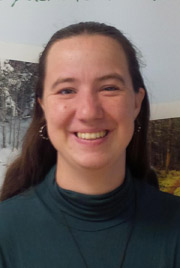Highlights of my NCC Conservation Internship
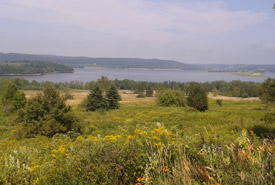
One of the most beautiful places we visited was Shamper’s Bluff, on the Kingston Peninsula of New Brunswick. (Photo by Joanna Hudgins)
I came into this internship full of excitement for the places I would see and the things I would do. After two years of studying to be a fish and wildlife technician in Central Ontario, I was beyond happy to be working in the Maritimes again. I wanted to spend time in salt marshes and on beaches, learning about glasswort and northern gannets and salt marsh copper butterflies — none of which live inland.
I was not disappointed. I spent my summer roaming salt marshes full of birds and fish, chasing butterflies down barrier beaches and at times, standing still and marvelling at the beauty that I was privileged to see.
As the steward of the land that it conserves, the Nature Conservancy of Canada (NCC) is responsible for caring for its properties. That means dealing with problems like invasive species or off-road vehicles (a more common threat on our coastal properties). It also means knowing what lives on our lands (especially species at risk) so that we can properly care for them.
That’s where the interns come in. We visit as many properties as we can throughout the province; checking last year’s trouble spots, removing invasive species and reporting any major issues. We do surveys for threatened species and note any rare ones.
It means a lot of hiking and scrambling over varied terrain, navigating by GPS and taking notes as we go. It means that you never know quite what you’re going to see, because you’re continually changing properties and landscapes.
I loved my summer full of travel and new sights, but there were definitely a few highlights:
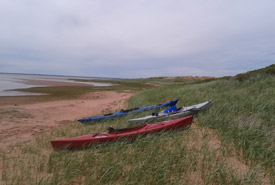
The Conway Sandhills, Prince Edward Island. (Photo by Joanna Hudgins)
The Conway Sandhills
In June, I was loaned to NCC’s Prince Edward Island team for a week of fieldwork. We spent two days on the Conway Sandhills, a series of long barrier islands off the coast of western PEI. We kayaked out to them, with terns wheeling overhead and great blue herons lifting off from the shallows as we approached.
The islands smelled of bayberry and stretched for kilometres along the coast. It poured rain throughout the second day, and the kayak back to shore was a hard pull of over an hour against a strong current. It was the sort of day that wasn’t exactly fun, but it sure made me feel alive.
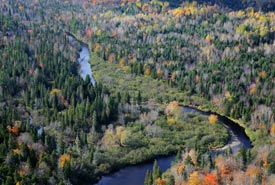
Bartholomew River, Miramichi, NB (Photo by Mike Dembeck)
An unexpected botany walk
In late July, I had the privilege of meeting Lewnanny Richardson, the biologist for Nature NB, and participating in monitoring the endangered piping plovers that nest on Brant Island in Tabusintac, New Brunswick.
The walk back to the boat after the survey became an unexpected botany walk, when Lewnanny offered to point out some sand dune and salt marsh plants to me. I was struck by the depth of Lewnanny’s knowledge as he named every plant by its English, French and scientific names, and I soaked up every bit of knowledge that I could.
Bartholomew River
In August, I packed up and headed to the Bartholomew River in central New Brunswick for 11 days to participate in habitat classification and a road survey for a 2,105-acre (852-hectare) property. For me, the best part was the discovery of a patch of old-growth yellow birch and sugar maple forest on the western edge of the property. We saw trees nearly a metre across in diameter, and the undergrowth was richly varied.
Standing in that cathedral of trees, I understood for the first time what we work towards when we conserve Acadian forest and help it to regenerate. The forests that I grew up in had been cut again and again, and had none of the grandeur of this one. Less than one percent of New Brunswick’s Acadian forest remains uncut, so it was both magical and discouraging to see that beautiful forest and to compare it to the forests I usually see.
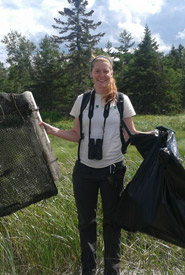
Claire Elliott at a Conservation Volunteers Event in Tabusintac, NB. (Photo by Joanna Hudgins)
A great partner
To work in any field job, you’d better have a stellar work partner who is as tolerant of soaking wet days and 30-degree heat as you are, because often you’ll be sharing a room, a tent, an office, a vehicle and a job. Mine came in the form of a cheerful master’s student from Ontario by the name of Claire Elliott.
Besides having excellent field skills, Claire’s good-natured tolerance of rain and 15-kilometre hikes made her an encouragement to me on hard days, and I had a lot of fun introducing my inland friend to hermit crabs, flounder and moon snails in tide pools. Your work partner can make or break your job, and Claire made mine.
These are only a few of the things that I loved about this summer. NCC’s internship program is a fantastic opportunity for those who are interested in land conservation or want a field job that offers variety. I loved the independence we were offered and the sense that we were doing something that mattered.
And would I do it again? Absolutely!

